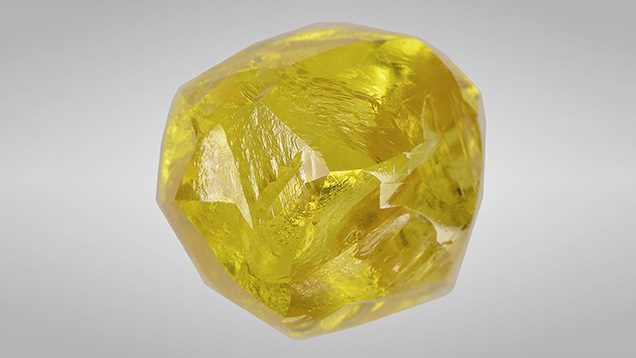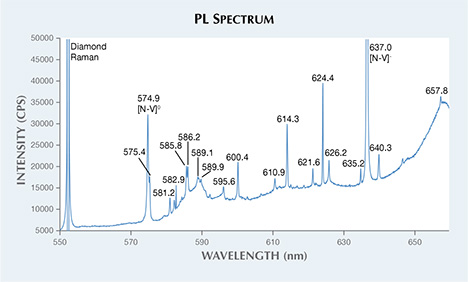Very Large Type Ib Natural Diamond

Nitrogen is the main impurity in diamond and during growth it is initially incorporated in the diamond lattice as isolated nitrogen atoms (C centers). Diamonds where the majority of nitrogen occurs in C centers are known as type Ib. While C centers are common in lab-grown HPHT diamonds, the occurrence of C centers in natural cratonic diamonds is extremely rare (<1% of all natural diamonds). Natural diamonds form deep in Earth’s mantle, where high temperatures result in nitrogen aggregating to form A centers (NS) and B centers (N4V).
GIA’s New York laboratory recently tested a large 13.09 ct gem-quality natural type Ib rough diamond. The diamond measured 13.51 × 11.56 × 10.18 mm, with rounded dodecahedral morphology and clear dissolution pits on some faces in a symmetrical pattern (figure 1). The diamond had a highly saturated, slightly orangy yellow color evenly distributed throughout the whole crystal. The diamond contained two tiny sulfide inclusions with their associated graphitic rosette fracture systems.
The infrared absorption spectrum revealed typical features of natural type Ib diamonds: a sharp peak at 1344 cm–1 and a broad band at 1130 cm–1. The absorption attributed to the A center (1280 cm–1) was rather weak. Spectral fitting showed that 75% of the nitrogen existed as C centers and 8% as A centers. This diamond did not contain any amber centers, which is consistent with the lack of plastic deformation lines or brownish hue.
The UV-Vis-NIR absorption spectrum, collected at liquid nitrogen temperature, showed a smooth and gradual increase in absorption from the near-infrared region to about 560 nm, and then a sharp increase to the high-energy side. C centers were the only color-introducing defect in this large diamond.
Photoluminescence (PL) spectra were collected at liquid nitrogen temperature with various laser excitations. Under 514 nm laser excitation, [N-V]0 at 574.9 nm and [N-V]– at 637.0 nm were detected. Many sharp emissions with unknown assignments were also observed (figure 2). With 830 nm laser excitation, weak emissions at 882/884 nm from Ni-related defects were observed.

Large type Ib diamonds with intense yellow color are rarely seen. GIA continues to study these rare diamonds to understand the geological processes that allow isolated nitrogen to be preserved in some natural diamonds. Preservation of C centers in these natural diamonds is typically attributed to very young formation ages or to storage of these diamonds at cooler temperatures in Earth’s mantle than most other diamonds. Ongoing isotopic age dating of sulfide inclusions, combined with temperature constraints, will provide the opportunity to evaluate how these enigmatic type Ib diamonds are preserved in natural cratonic settings.



